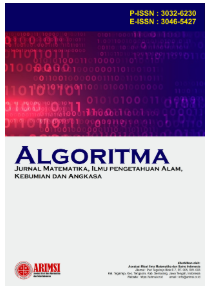Analisis Pelaksanaan Evaluasi Formatif dan Evaluasi Sumatif dalam Pembelajaran Matematika di SMK N 6 Padang
DOI:
https://doi.org/10.62383/algoritma.v3i4.628Keywords:
Learning evaluation, mathematics, formative evaluation, summative evaluation, vocational schoolAbstract
Learning evaluation plays a central role in ensuring the success of the educational process, especially in mathematics learning at Vocational High Schools (SMK) that require integration between theory and practice. This study aims to comprehensively analyze the implementation of formative and summative evaluations at SMK N 6 Padang. Using a descriptive qualitative approach, data was obtained through observations, in-depth interviews, and document analysis. The results show that formative evaluations are carried out systematically through essay tests, contextual quizzes, discussions, and observations of student participation. This evaluation can monitor learning progress, encourage active engagement, and strengthen students' conceptual understanding. Meanwhile, summative evaluations are consistently applied using multiple-choice questions that encompass low-order thinking skills (LOTS) to high-order thinking skills (HOTS). in line with the learning objectives and curriculum. Both forms of evaluation have proven to be very effective, based on teacher observations and feedback. Although not all aspects were followed up explicitly, the assessment mechanisms applied reflect the principles of modern evaluation that are adaptive, fair, and competency-based. It can thus be concluded that the evaluation is running very effectively at 88.88%, and the evaluation implementation at SMK N 6 Padang not only succeeded in measuring student achievement but also became an instrument to strengthen the quality of learning relevant to the demands of industry and the developments in 21st-century education.
Downloads
References
Alsina, A., Maurandi, A., Ferre, E., & Coronata, C. (2021). Validating an Instrument to Evaluate the Teaching of Mathematics Through Processes. International Journal of Science and Mathematics Education, 19(3), 559–577. https://doi.org/10.1007/s10763-020-10064-y
Ansya, Y. A., Alfianita, A., Syahkira, H. P., & Syahrial, S. (2023). Peran Evaluasi Pembelajaran pada Mata Pelajaran Matematika Kelas V Sekolah Dasar. Indiktika : Jurnal Inovasi Pendidikan Matematika, 6(2), 173–184. https://doi.org/10.31851/indiktika.v6i2.15030
Divayana, D. G. H., Suyasa, P. W. A., & Widiartini, N. K. (2021). An innovative model as evaluation model for information technology-based learning at ICT vocational schools. Heliyon, 7(2), e06347. https://doi.org/10.1016/j.heliyon.2021.e06347
Fan, T., Song, J., & Guan, Z. (2021). Integrating diagnostic assessment into curriculum: A theoretical framework and teaching practices. Language Testing in Asia, 11(1), 2. https://doi.org/10.1186/s40468-020-00117-y
Fuchs, L. S., & Fuchs, D. (1986). Effects of Systematic Formative Evaluation: A Meta-Analysis. Exceptional Children, 53(3), 199–208. https://doi.org/10.1177/001440298605300301
Halimi, K., & Seridi-Bouchelaghem, H. (2021). Students’ competencies discovery and assessment using learning analytics and semantic web. Australasian Journal of Educational Technology, 37(5), 77–97. https://doi.org/10.14742/ajet.7116
Nieminen, J. H., Asikainen, H., & Rämö, J. (2021). Promoting deep approach to learning and self-efficacy by changing the purpose of self-assessment: A comparison of summative and formative models. Studies in Higher Education, 46(7), 1296–1311. https://doi.org/10.1080/03075079.2019.1688282
Owen, J. M., & Lambert, F. C. (1995). Roles for Evaluation in Learning Organizations. Evaluation, 1(2), 237–250. https://doi.org/10.1177/135638909500100207
Préfontaine, C., Gaboury, I., Corriveau, H., Beauchamp, J., Lemire, C., & April, M.-J. (2022). Assessment tools for reflection in healthcare learners: A scoping review. Medical Teacher, 44(4), 394–400. https://doi.org/10.1080/0142159X.2021.1998400
Rahmadia, A., & Handican, R. (2023). Bagaimana Evaluasi yang Efektif dalam Pembelajaran Matematika: Tinjauan Persepsi Guru Matematika. Griya Journal of Mathematics Education and Application, 3(2), 357–371. https://doi.org/10.29303/griya.v3i2.332
Retnawati, H., Hadi, S., & Nugraha, A. C. (2016). Vocational High School Teachers’ Difficulties in Implementing the Assessment in Curriculum 2013 in Yogyakarta Province of Indonesia. International Journal of Instruction, 9(1), 33–48. https://doi.org/10.12973/iji.2016.914a
Seneviwickrama, K. L. M. D. (2020). Theory of change: Can its application really make a change? Journal of the College of Community Physicians of Sri Lanka, 26(4), 234. https://doi.org/10.4038/jccpsl.v26i4.8391
Siu, O., Lui, K. F. H., Huang, Y., Ng, T. K., & Yeung, W. L. V. (2024). An efficient, reliable and valid assessment for affective states during online learning. Scientific Reports, 14(1), 15768. https://doi.org/10.1038/s41598-024-66974-2
Viscione, I., D’Elia, F., Vastola, R., & Sibilio, M. (2017). Psychomotor Assessment in Teaching and Educational Research. ATHENS JOURNAL OF EDUCATION, 4(2), 169–178. https://doi.org/10.30958/aje.4-2-5
Zhang, J. (2023). Cognitive Status Analysis for Recognizing and Managing Students’ Learning Behaviors. International Journal of Emerging Technologies in Learning (iJET), 18(16), 150–164. https://doi.org/10.3991/ijet.v18i16.42705.
Downloads
Published
How to Cite
Issue
Section
License
Copyright (c) 2025 Algoritma : Jurnal Matematika, Ilmu pengetahuan Alam, Kebumian dan Angkasa

This work is licensed under a Creative Commons Attribution-ShareAlike 4.0 International License.





